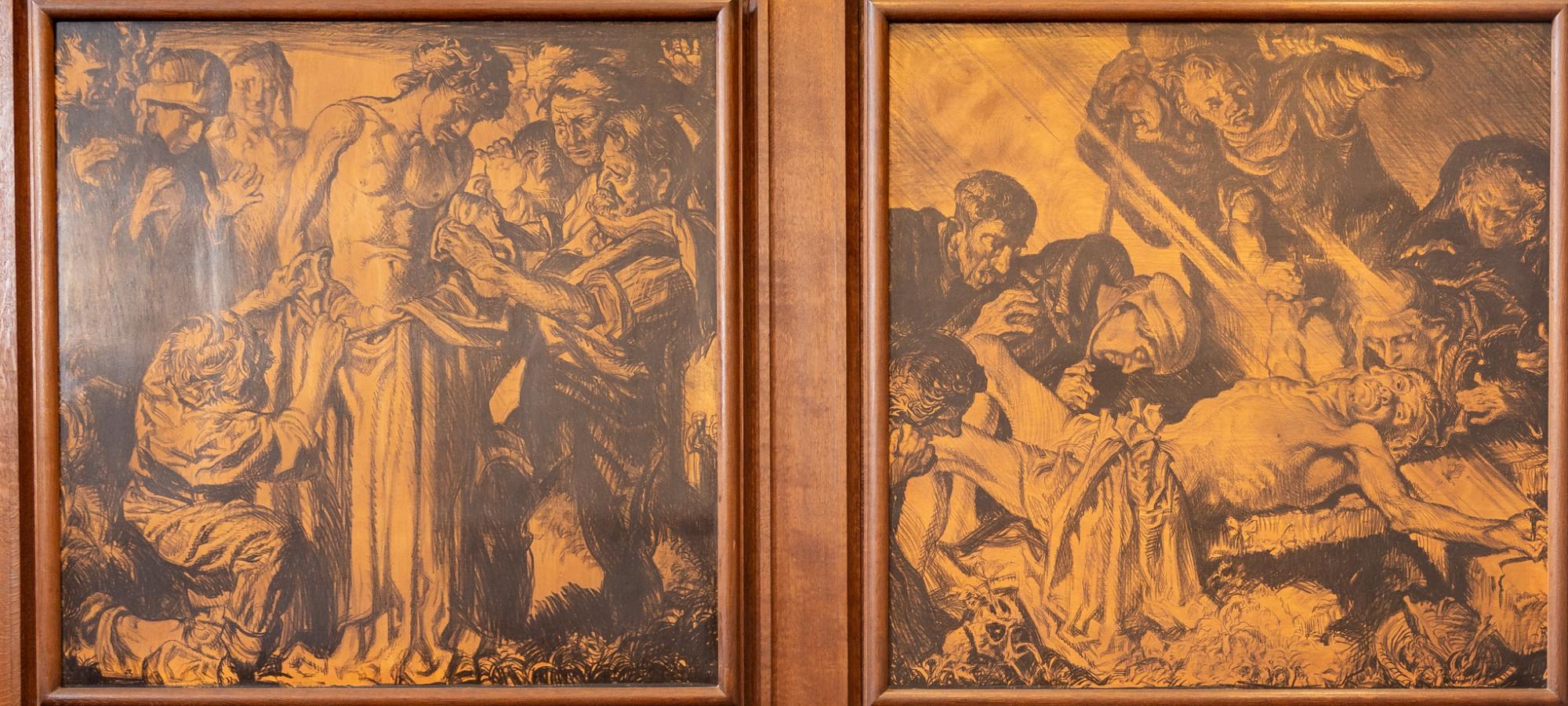
Sir Frank Brangwyn’s Stations of the Cross
Sir Frank Brangwyn (1867-1956) was the product of an Anglo-Welsh Catholic family, and a prolific, versatile and successful artist and craftsman. He is best remembered as a war artist and muralist, but religious paintings formed a significant aspect of his oeuvre. His first attempt at a Stations of the Cross was made for Father Thomas Ryan’s leper mission in Pretoria (1920-22). Brangwyn was generous with his work; for example, he presented a large painting of the confession of St Peter to one of Britain’s most aesthetically ambitious Catholic churches, St. Peter’s, Morningside, Edinburgh, the creation of Canon John Gray, poet and priest, and André Raffalovich.
The back-story of the Campion Hall Stations derives from another generous project. Brangwyn, who was born in Bruges where his father was then working, was profoundly moved by the mass destruction of the First World War – not only the loss of human life, but the damage to Belgian churches and the loss of their treasures. He was Chairman of the English Committee for Dixmude, a town which had suffered particularly badly. Feeling as he did, it is not surprising to find that he was successfully recruited to a project to create and donate a set of Stations of the Cross to Arras Cathedral, along with an edition of fifty prints to be given to churches all over Belgium, as a gesture of post-war reconstruction. Brangwyn took the commission extremely seriously, and made hundreds of preliminary drawings. Unfortunately, when the work was at quite an advanced stage, his model, Cervi, died. They had worked together particularly closely, since Cervi had thrown himself into the task of representation with great religious feeling, and without him, Brangwyn felt unable to continue with the projected paintings. However, between 1930 and 1934, he created a set of woodcut Stations. Subsequently, there was a joint exhibition of some of Brangwyn’s own drawings together with lithographs by his friend Albert de Belleroche. This rekindled Brangwyn’s own dormant interest in lithography, and de Belleroche suggested that, on the basis of his existing drawings, Brangwyn might finally realise a set of Stations, not as paintings, but as lithographs. He did so, and two series were printed onto sycamore, a process which gives an extremely durable result. One was exhibited in Brighton in the summer of 1935 before being presented to Campion Hall. The other went to the monastery of St André in Zevenkerken. The lithographs were also printed onto paper and issued as a book,The Way of the Cross: an interpretation by Frank Brangwyn, by Hodder and Stoughton in 1936, with a commentary by G.K. Chesterton. An oil study for the seventh Station is also at Campion Hall: this was presented to Father D’Arcy by Brangwyn, and dates to ca. 1920. It is one of the original studies for the Arras Cathedral Stations, for which Cervi was the model.
Brangwyn’s religious works may be associated with the conscious revival of Catholic painting which is embodied in the Guild of Catholic Artists and Craftsmen, founded 1930. Another highly successful Catholic painter, Glyn Philpot, as its first president. The Tablet observed, ‘if the Guild is to make known and understood the principles of Christian Art, there must be some measure of unanimity in the minds of its members as to what these principles are. Spiritual Conferences will be given at least quarterly by the chaplain, Father Martin D'Arcy, S.J., M.A., to help the members live their faith. Brangwyn was also, of course, associated with Eric Gill, another friend of Father D’Arcy’s: he bought a house in Ditchling, where Gill maintained his community, and joined the Guild of St Joseph and St Dominic.

